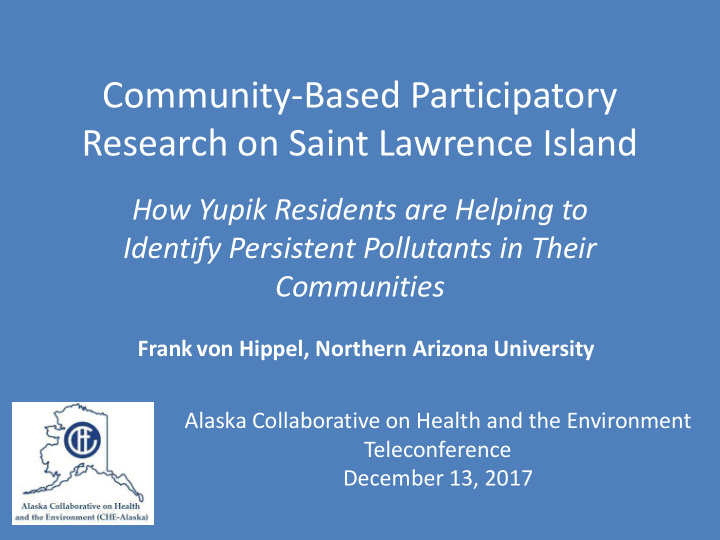



Community-Based Participatory Research on Saint Lawrence Island How Yupik Residents are Helping to Identify Persistent Pollutants in Their Communities Frank von Hippel, Northern Arizona University Alaska Collaborative on Health and the Environment Teleconference December 13, 2017
Persistent Organic Pollutants (POPs) Perfluorinated compounds Polybrominated diphenyl ethers (PBDEs) (PFCs) Polychlorinated biphenyls (PCBs) Chlorinated pesticides
von Hippel, F.A., Trammell, E.J., Merilӓ , J., Sanders, M.B., Schwarz, T., Postlethwait, J.H., Titus, T.A., Buck, C.L. & Katsiadaki, I. (2016). The ninespine stickleback as a model organism in arctic ecotoxicology. Evolutionary Ecology Research 17:487-504.
Health Patterns of Concern Cancers • Thyroid disease • Diabetes • Heart disease • Birth defects, low birthweight babies, premature births, stillbirths, • miscarriages Other reproductive health problems •
“Protecting the Health of Future Generations: Assessing and Preventing Exposures to Endocrine- Alaska Disrupting Chemicals in Two Alaska Native Arctic Communities on St. Lawrence Island” Russia Savoonga Gambell Northeast Cape National Institute of Environmental Health Sciences RO1, 2011-2016 Miller, P.K., von Hippel, F.A., Buck, C.L. & Carpenter, D. NIEHS 1RO1ES019620
Community outreach & CBPR: Pam Miller & ACAT, SLI Working Group Ecotoxicology: Frank von Hippel Endocrinology: Loren Buck Human health research: David Carpenter Gene expression: John Postlethwait
PCBs in blood serum of St. Lawrence Island people
Mean [PCB] (ppb, wet weight) 5 4.5 4 3.5 3 2.5 2 1.5 1 0.5 0 Background Background Savoonga residents Savoonga residents concentration in U.S. concentration in U.S. without camps at NEC with camps at NEC residents, low residents, high
Mean [PCB] (ppb, wet weight) 5 4.5 4 3.5 3 2.5 2 1.5 1 0.5 0 Background Background Savoonga residents Savoonga residents concentration in U.S. concentration in U.S. without camps at NEC with camps at NEC residents, low residents, high data from Carpenter & Miller (2011)
Mean [PCB] (ppb, wet weight) 5 4.5 4 3.5 3 2.5 2 1.5 1 0.5 0 Background Background Savoonga residents Savoonga residents concentration in U.S. concentration in U.S. without camps at NEC with camps at NEC residents, low residents, high data from Carpenter & Miller (2011)
White Alice Communication Site, operational 1957-1972 Above ground structures & debris removed in 2003 $123 million spent on site remediation
1) At the conclusion of site remediation, is remaining PCB contamination due primarily to the formerly used defense site or to atmospheric deposition? 2) Is the remaining PCB contamination biologically relevant for resident freshwater fishes? 3) Do contaminant levels have implications for the health of the Yupik people on St. Lawrence Island?
gonads, liver & kidney split samples RNA and histology thyroid DNA for sex RNA & histology genotyping brain RNA + contaminant chemistry
von Hippel, F.A., Miller, P.K., Carpenter, D.O., Dillon, D., Smayda, L., Katsiadaki, I., Titus, T.A., Batzel, P., Postlethwait, J.H. & Buck, C.L. (2017). Endocrine disruption and differential gene expression in sentinel fish on St. Lawrence Island, Alaska: health implications for indigenous residents. Environmental Pollution 234:279-287.
Levels of PCBs in the fish are still high, even though clean-up is considered complete… and contaminant chemistry reveals a mostly local source (FUDS), but are these [PCB] biologically meaningful?
Is the endocrine system of the fish disrupted?
Sites downstream of FUDS “Reference” sites
Is gene expression of the fish disrupted?
p < .03 5-mC DNA ELISA Kit
Gene expression results… Stickleback collected at more contaminated reaches of the Suqitughneq River expressed numerous genes differentially compared to fish collected at less contaminated reaches, including genes relevant to DNA replication, response to DNA damage, and cell signaling. Decreased expression of DNA repair genes could increase the accumulation of mutations and intensify the potential for carcinogenesis. Reduced cell signaling might exacerbate the risk of carcinogenesis by decreasing normal pathways of cell cycle arrest and apoptosis for genetically damaged cells. Conservation of the vertebrate endocrine system and genome...
What’s next for St. Lawrence Island? RO1 renewal: – Mechanistic studies with stickleback to identify upstream biomarkers of human disease – Focus on childhood development in Gambell & Savoonga Potential solutions…
Practical implications for arctic communities Environmental remediation standards Prevalence of contaminated sites throughout the Arctic CBPR is informing policy at the local, state, national, and international levels
Recommend
More recommend